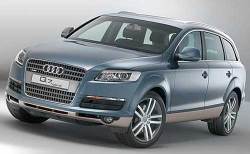Audi Q7 more efficient
The Audi Q7 is not only a great sports utility vehicle but has also turned into a fantastic platform for testing new automotive technology.
The Designers at Audi have been able to plug many already successful components from the A6 into this flexible SUV platform. A great Audi Q7 video has been added at the end of this short post for your viewing pleasure.
 The Audi Q7 is giant. It is much wider, longer and even taller than the Volkswagen Tuareg. You will have to be careful with the large rear doors that need to be opened carefully in tight parking spots. The back of the Q7 is very elegant with flush-mounted tail lights and smooth European flowing body lines.
The Audi Q7 is giant. It is much wider, longer and even taller than the Volkswagen Tuareg. You will have to be careful with the large rear doors that need to be opened carefully in tight parking spots. The back of the Q7 is very elegant with flush-mounted tail lights and smooth European flowing body lines.
The Audi Q7, the company presented at the Shanghai Car Show has a different updated look. But not only the exterior has changed, technically the car has undergone some changes too.
The fuel consumption is reduced on all the models. The press release talks about the fact that the new Audi is also available with the cleanest diesel technology in the world, the TDI clean diesel.
What’s changed? The grille is the most significant one. The new models come with vertical bars with high chrome finish that gives the German Suv an extra luxury look. The bottom section may be painted in black or gray and the bumpers were changed. When the lights go on the street lights up in cool blue glow.
This is because the Audi Q7 is equipped with Xenon lighting. Also an optional adaptive system with Xenon lights is offered. This means the headlights rotate with the steering angle. All around, the new Audi is equipped with the latest LED lighting for an impressive image at night.
Extra Audi efficiency
All gasoline and diesel engines for the new Audi Q7 have direct fuel injection. The same goes for the Audi Q7 3.0 TDI clean diesel. The 3.0-liter V6 TDI has a De-NOx catalyst with Ad Blue injection. It’s Ad Blue additive ensures that nitrogen oxide is converted into harmless nitrogen and oxygen.
The exhaust system ensures that the Audi TDI meets the strictest emission standards in the world, which is expected in September 2014 takes effect. The Audi Q7 Clean diesel fuel allows an average of 8.9 l/100 km in fuel consumption.
 The other engines available for the Audi Q7 are also more efficient. Mainly because of the recovery system that convert mechanical brake and roll energy into electrical energy and stored in the battery. This system provides a lower fuel consumption and therefore lower CO2 emissions (reduction up to 5 g / km).
The other engines available for the Audi Q7 are also more efficient. Mainly because of the recovery system that convert mechanical brake and roll energy into electrical energy and stored in the battery. This system provides a lower fuel consumption and therefore lower CO2 emissions (reduction up to 5 g / km).
The 3.0 TDI with 176 kW/240 hp is satisfied with 9.1 l/100 km. Audi Q7 4.2 TDI (250 kW/340 hp) rides on an average of 9.9 l/100 km (was 11.1 l/100 km). The Audi Q7 V 12 TDI (with a power of 368 kW/500 hp) consumes 11.3 l/100km.
The average consumption of the 3.6 FSI petrol version (206 kW/280 hp) is 12.1 l/100 km and the 4.2 FSI V8 is 12.7 l/100 km.
The standard of luxury and top comfort on this Audi. Through the six speed tipronic transmission you control the Quattro permanent four-wheel drive, you have got electronic air conditioning and a good hi end audio system. And if you are not yet fully satisfied, you can opt into a B & O sound system, complete with infotainment system for your navigation, telephone and music.
Audi Q7 4.2 TDI and 6.0 TDI has adaptive air suspension with three preset modes standard. Options like ceramic disc brakes, adaptive cruise control, Audi lane assist, the Audi parking system and comfort seats are made available.
The Q model has also provided a solid platform for Hybrid suv testing and development. One of the most environmentally friendly features of the Audi Q7 Hybrid is a set of solar panels embedded into its (Open Sky) sunroof.
The solar panels provide power for the electronic air conditioning system. This allows the sun’s energy to be converted into a very efficient interior cooling system. The car ac system on the Q7 hybrid has been switched over from hydraulic to electrical operation.
Audi Q7 video
This article and more like them you can find through MyArticleNetwork, and the best of it, it’s free.
Interested in classic bikes? Have a look at: Motor Klassiek

